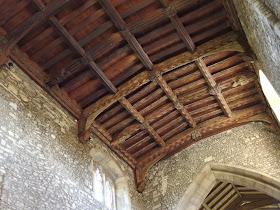In a recent post I told you about the Rev Henry Cust, one time rector of Cockayne Hatley, who became obsessed with buying beautiful carvings till his little church overflowed with all his acquisitions. I understand how that happens; I've collected far more photos of intricate woodwork than I really have space to show you. However here are a few more:
Between the heads of the early saints are these delightful cherubs. You might excuse the artist for spending a little less time on these peripheral figures, though actually they seem to be carved with even more loving care than the main subjects.
The above tableau of apparently under-age winemakers is just one scene from the elaborately carved altar rail.
Now lets move on to one of my favourite words: misericord. Misery-what? I hear some of you say. Misericord: a perch for a monk's bum, of course...
In the early monasteries, like the ones in Flanders where these choir stalls originated, monks were expected to stand for the duration of the interminable services. As there has never been a retirement age for monks, some of the older ones found this difficult - so they cheated! A small ledge was provided under the upturned seat so that they could settle their buttocks upon them and still appear to be standing. Such seats were called "mercy seats" or "misericords"
They can turn up (literally!) in any old religious building and, strangely, they sometimes depict rather non-religious carving. The one above appears to be a "green man", an odd fellow with leaves instead of hair. Besides giving its name to many English pubs, it's also thought to be a pagan symbol. It's usually said to be an exclusively English motif - but these seats originate from Flanders (??).
The rather scary figure seen above can be encountered in (I think) Therfield church and is part of someone's memorial. Not the sort of thing we'd decorate a tomb or memorial with today but in its time quite normal. The carving is rather fine despite its gruesome subject.
Lets hurriedly move on to the church at Hemingford Abbots where there's a splendid fifteenth-century oak roof with carved angels:
I know they don't look much like angels but that's what they're always called. The three (out of a total of 22) which I show you here are all musicians. On the left is what's supposed to be a cittern, an early English version of the guitar; in the centre is a harp; and on the right is a shawm - which seems to have more finger-holes than anyone has fingers.
Many of these carved and often painted roofs have succumbed to the ravages of the passing centuries as church roofs are notoriously leaky structures, but very few were touched by the Puritan iconoclasts of the seventeenth century. Even William Dowsing and his distinctly unmerry band, who made a thorough job of smashing anything at ground level, failed to have sufficient persistence to climb up to the rafters to complete their task. Most often they left instructions with the church wardens that the offending woodwork should be removed, though in most cases they also lacked the necessary resolve.
So here they remain, for us to crick our necks and wonder at today.
Take care.









Wonder at indeed, John. Thank you for your eye for details and sharing the beauty I would never have seen otherwise.
ReplyDeleteSuch interesting carvings! I loved the story about the standing monks.
ReplyDeleteThe details are remarkable. And the tombstone carving, I have never seen anything like it before.
ReplyDeleteIncredible wood carvings with stunning details. I would have loved seeing these pieces being created. I am amazed, thanks for sharing these priceless carvings.
ReplyDeleteThese are splendid...can't imagine the skeleton like that. LOL One of New Tricks series featured The Green Man...I had never heard of him till that show.
ReplyDeleteI can see why you are fascinated with the carvings and have so many photos of them. They are wonderful works of art.
ReplyDeleteReally amazing carving! That skeleton is quite unique.
ReplyDeleteI'm always amazed at the quality of ancient art. Love the way you write. I always get a giggle while learning interesting facts.
ReplyDeleteHi John - stunning wood work ... I'm sorry for now I can't do the post justice - but I'd love to visit the church at some stage in the distant future ... beautiful photos - cheers Hilary
ReplyDeleteWow! Imagine the time it took to do these carvings--esp that skeleton.
ReplyDeleteSo much craftsmanship tucked into these churches across the countryside. Thank you for bringing it to light and sharing. I shudder to think how much was lost.
ReplyDelete